
Scenes from Steamboat Round the Bend
Will Rogers as Doctor John Pearly
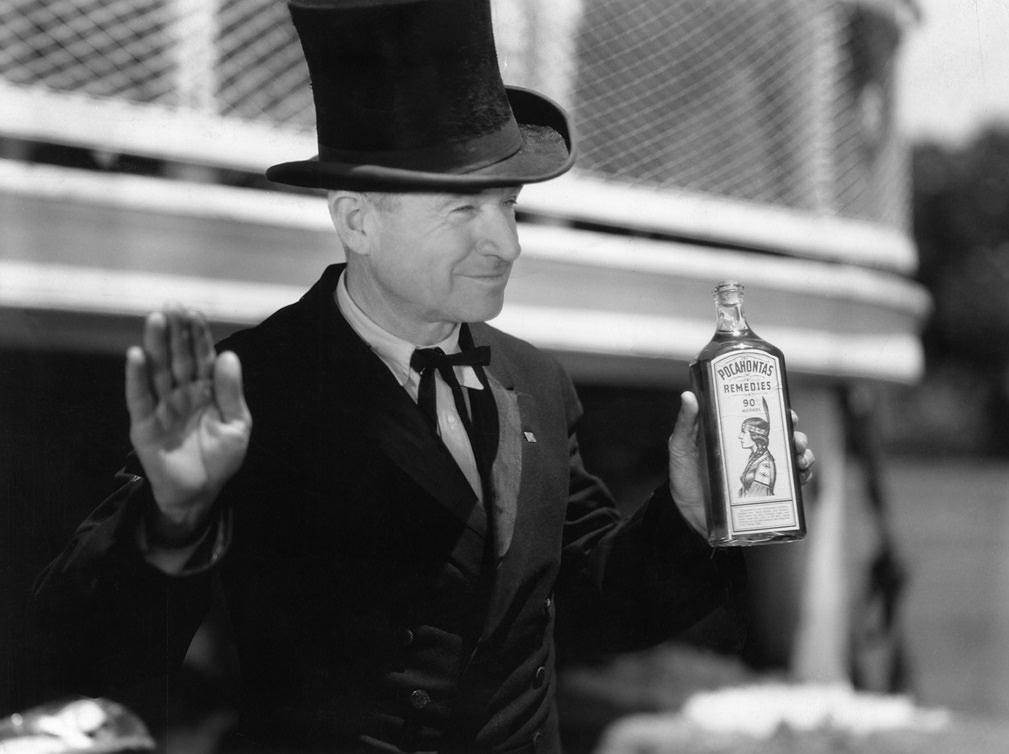
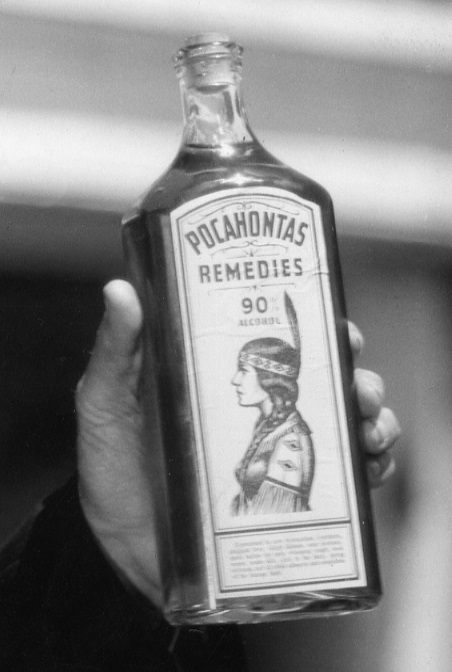
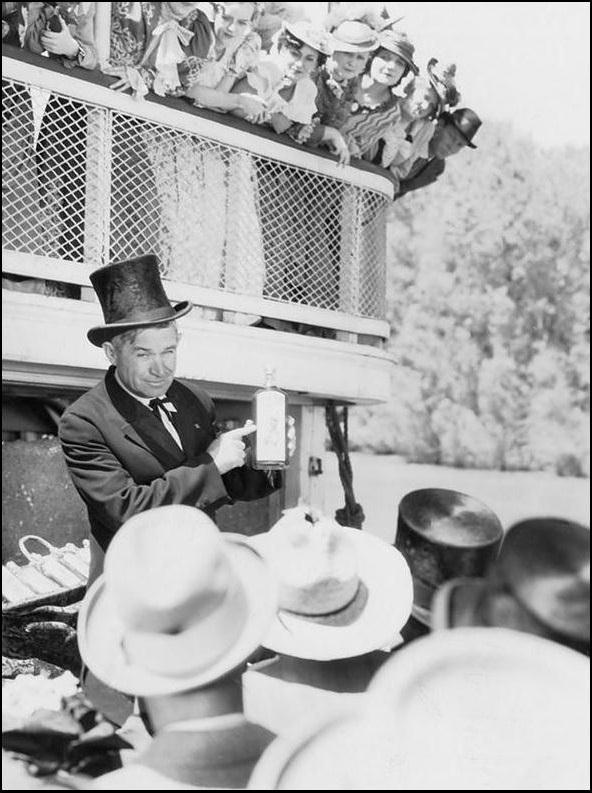
Here Will Rogers as Doc John Pearly is peddling his "Pocahantas remedy" to passengers aboard the PRIDE OF PADUCAH.
DIALOGUE FOR THE POCAHONTAS "SPIEL" THAT Doctor John "BALLYHOOS" ABOARD THE PRIDE OF PADUCAH SI JENKINS IS THE FUNNY LITTLE OL' CHARACTER THAT PROCLAIMS THAT HIS GRANDMOTHER WAS A "SMITH" TOO . . .
Look at that. You see that? See that picture on there? Yeah, that's Pocahontas, the wonderful little Indian woman.
You know, you all know the story of Pocahontas. You know? That saved John Smith's life, you know? Well, John Smith wanted to get this remedy from Pocahontas, you know? Course, it's just made out of pure roots and herbs that she picked up on the hillside. But she wouldn't give him this remedy. He couldn't get it. He had to marry her to get it. Oh, yes, he did. He had to marry her to get the remedy. And that's how it got into the Smith family. And that's been handed down from generation to generation from Smith to Smith right on down... and that's how it come clear down to me. My great-grandmother was a Smith.
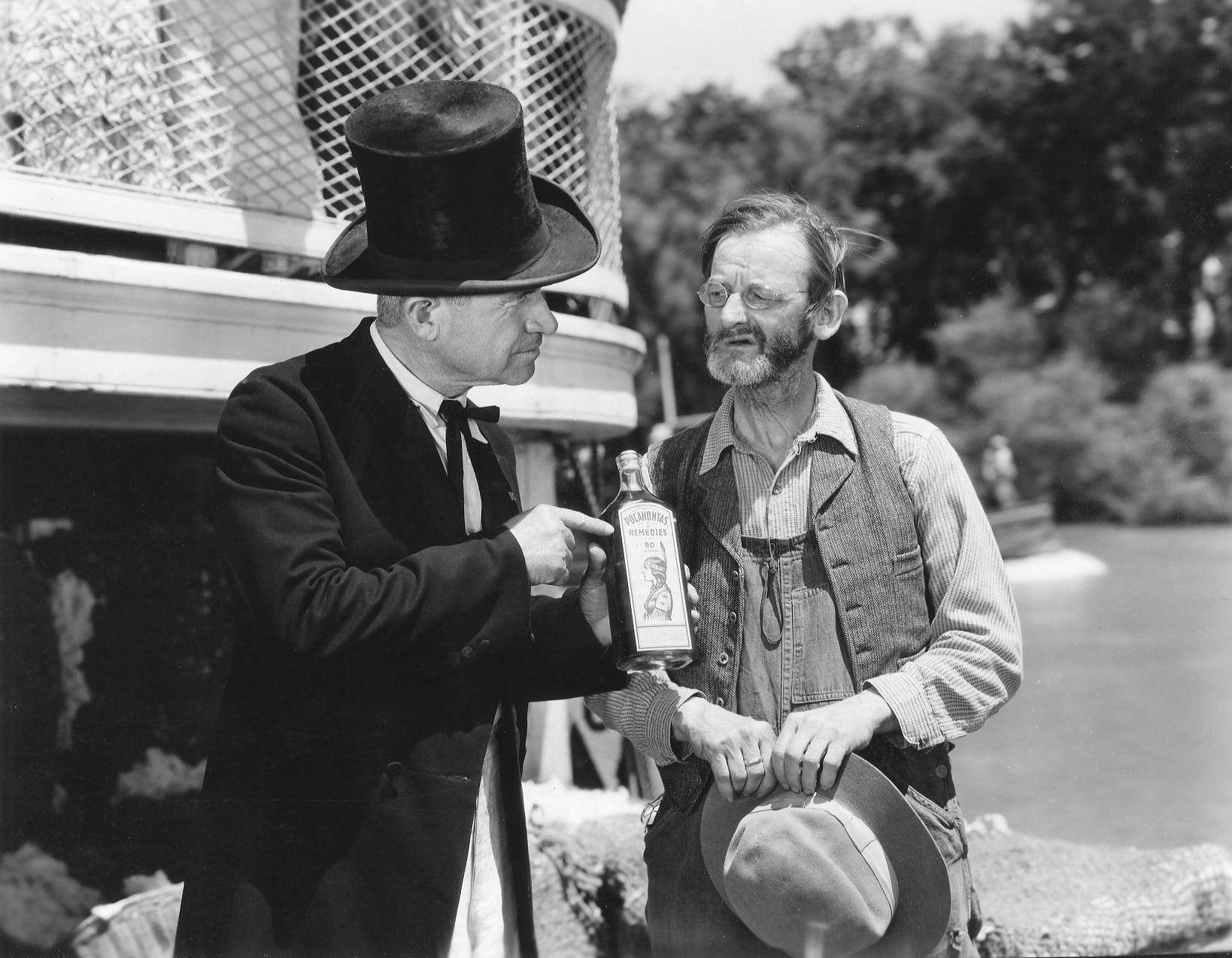
This is Si Jenks, a character actor best known for his sidekick roles in Westerns. He was born Howard Jenkins in Norristown, PA in 1876, and worked in Vaudeville with his wife until 1924 when he began playing in silent movies. His screen name "Si" was probably short for Silas, Tom Sawyer's uncle's name. He appeared in more than 200 movies, and lived to be 93, living out his life in Woodland Hills, Los Angeles.
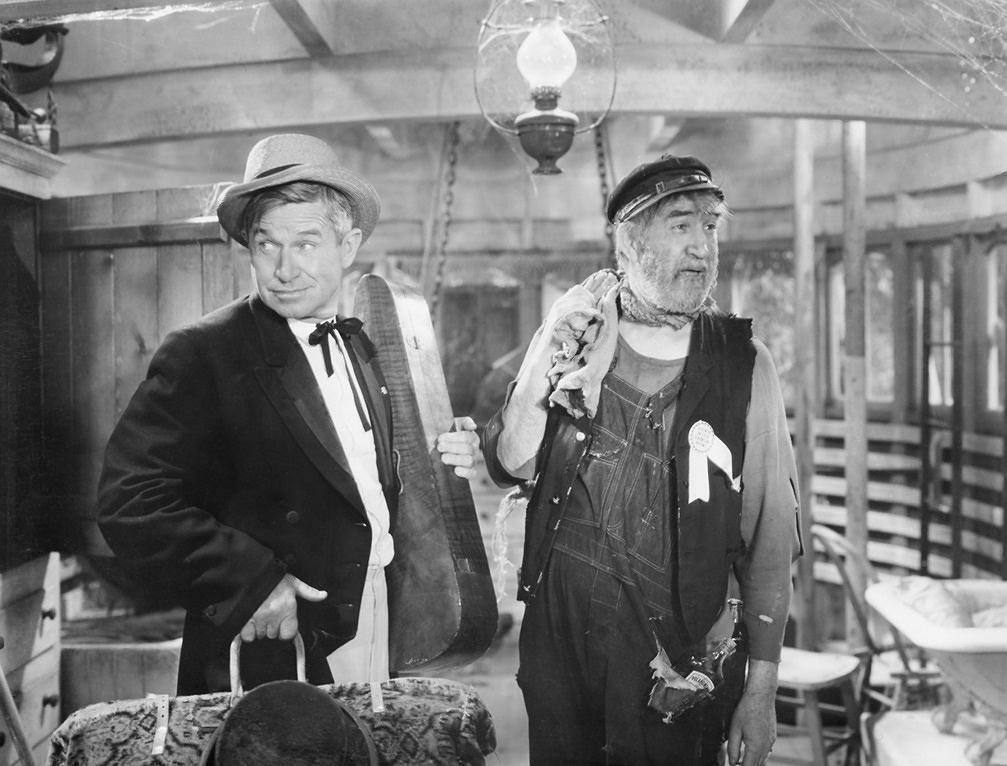
Note two bottles of Pocahontas remedy in the pockets of Efe's big overalls. This is the scene where the cabin of the CLAREMORE QUEEN is still looking like a pig sty. Doc plays motivational speaker to prod reluctant Efe into do some heavy housekeeping:
DOC - Come on in here. Well, engineer, what do you think of it?
EFE - Kind of looks as though a lot of rats have to find themselves a new hole.
DOC - Well, of course it don't look so good right now. But you got to remember that well, a steamboat is a female, you know? And when they're struttin' up and down the river where everybody's lookin' at 'em they're just like a woman with a new Easter bonnet on. But when nobody ain't lookin' at 'em, why they get kind of careless and don't care.
EFE - Yeah—sloppy.
DOC - Sloppy. That's right. But with a good, live man on this boat like you are say, you can make this thing perk up and strut. Get some paint on her nose and get these chickens out of here. We can put them right in the pot now. Here. Here. Start flirtin' with that. (DOC hands EFE a broom)
EFE - But, Doc, you told me yourself that a man couldn't do a lick of work when he's on Pocahontas.
DOC - Oh, that's the first bottle. But after that you've got to work to get the best results out of it. Now, hurry up. Duke's gonna be here any day now.
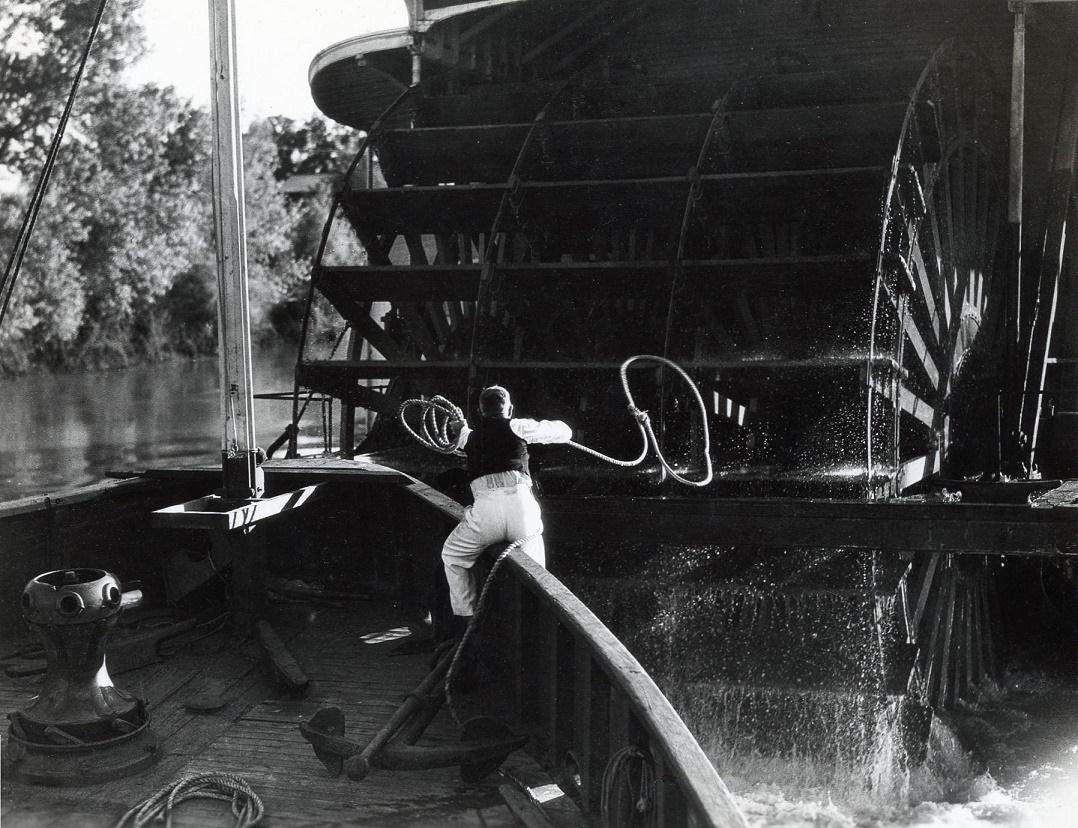
This is the classic iconic view of Will Rogers at the bow of the CLAREMORE QUEEN lasso'ing the stern of PRIDE OF PADUCAH in order to catch a ride from Cap'n Eli one night. Rogers was legendary for his ropin' skills from his cowboy days in Oklahoma and on stage with the Ziegfeld Follies in New York City where Will first began talkin' to the audience on all kinds of subjects that led to him becoming a popular commentator and humorist.
(Below the dialogue that accompanies the scenes of Lasso'ing the PRIDE OF PADUCAH's stern and Cap'n Eli's discovery of the prank in the morning):
Doctor John: (to Fleety Belle): Say, look here, honey. Can you get over there and get right in behind him?
FLEETY BELLE: Sure, I can. Yeah.
Doctor John: In his backwash?
FLEETY BELLE: Uh-huh.
Doctor John: Because if you can, the Lord has given me an idea. Here she comes!
CAP'N ELI: Mink, when I get sound asleep, take this here cigar out of my mouth, will ya? Burnt up three, four steamboats that-a-way.
CAP'N ELI: Mornin', Mink.
MINK (the pilot): Mornin', Captain Eli! Have a good night?
CAP'N ELI: Holy jumpin' catfish! (Discovering that the CLAREMORE QUEEN is right behind them) Fletch! Fletch! Get an ax! Get an ax and chop that old scow loose! Doc, you connivin' old scoundrel! It 'taint fair! It 'taint fair!
Doctor John: I'm just as sore 'bout it as you are, Captain Eli... when I found out we'd been pushin' you all night.
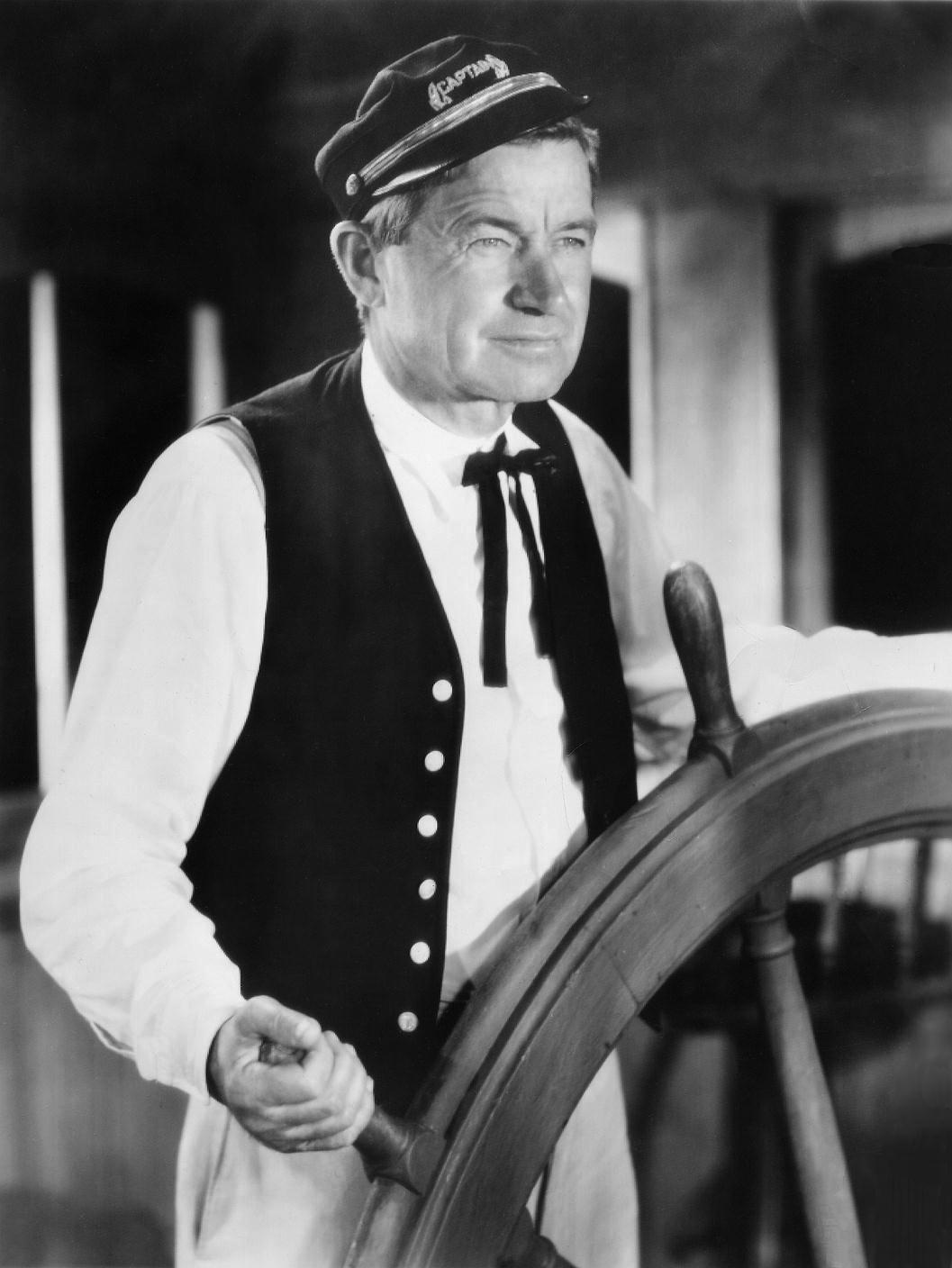
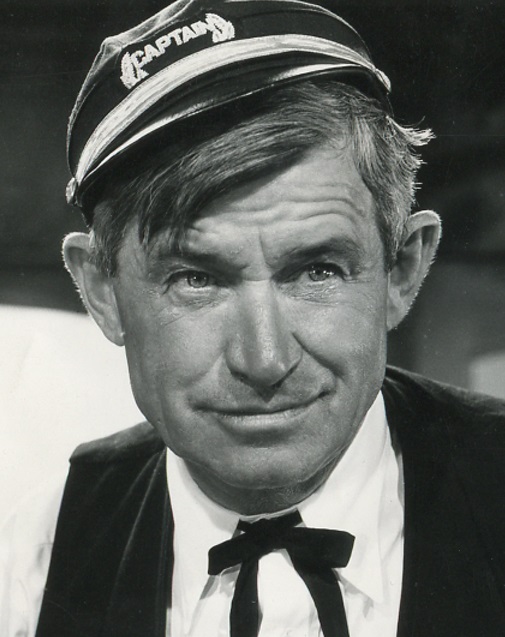
Rogers, the star, died in a plane crash before the film's debut.
All dialogue in this section is derived from the "S.S. Springfield Movie Script UK - Steamboat Round the Bend" page springfieldspringfield.co.uk or scripts.com.
Origins of the name for Will Rogers' boat, the "Claremore Queen." Claremore was Will Rogers' home town in Oklahoma.
CLAREMORE, OKLAHOMA
By Maxine Bamburg
Oklahoma Historical Society
The county seat of Rogers County, Claremore covers a land area of approximately twelve square miles at an elevation of 602 feet. It is located twenty-nine miles northeast of Tulsa. The area is probably best known as the home of Will Rogers. Claremore's Will Rogers Memorial Museum displays photographs and Rogers's original manuscripts, private letters, and personal papers. The twenty-acre grounds were purchased by the humorist in 1911 for a retirement site and were donated to the city by his widow after his death in 1935.
A post office was established there on June 25, 1874, thirty-three years prior to Oklahoma statehood, when the region was the Cherokee Nation, Indian Territory. The town was named for the Osage Indian chief Claremore, whose nearby village was destroyed during the Battle of Claremore Mound in 1817. However, the town's founding date is in dispute. The Atlantic and Pacific Railroad reached the townsite in 1882 and the Kansas and Arkansas Valley Railway arrived in 1889. The St. Louis and San Francisco Railway subsequently acquired the former, and the Missouri Pacific Railway Company obtained the latter. The Claremore Progress, the town's first newspaper, started in 1893. Other early publications were the Claremore Messenger, the Rogers County Leader, and the Claremore Courier.
During the drilling of a test oil well in 1903, an artesian mineral water flow was struck. Visitors soon arrived to seek the radium water's supposed healing powers. Claremore was incorporated on May 2, 1903. It was designated the Rogers County seat after 1907 statehood, and the Oklahoma Military Academy was established there in 1919. Construction on the present Rogers County courthouse, a project assisted by the Works Progress Administration (WPA), started in 1937.
Claremore had a population of 855 in 1900. That number increased from 2,866 in 1910 to 3,720 in 1930. In 1931 the community was served by the St. Louis and San Francisco Railway and the Missouri Pacific Railway companies as well as by the Missouri, Kansas, and Oklahoma, Rankin Rapid Transit, Wardway, and Pickwick-Greyhound bus lines. The business district included two banks, one wholesale mercantile establishment, a dehydrating plant, and the Will Rogers Hotel, which is listed in the National Register of Historic Places (NR 94001508). Claremore's five other National Register properties include the Belvidere (NR 82003696) and Mendenhall's Bath House (NR 83002127).
Claremore natives include singer Patti Page, astronaut Stuart Roosa, and Lynn Riggs, author of Green Grows the Lilacs, from which the musical Oklahoma! was adapted. Reputedly the world's largest private gun collection is housed in Claremore's J. M. Davis Arms and Historical Museum. Donated by Davis to the state in 1969, the museum also displays animal horns, beer steins, American Indian relics, and old musical instruments.
Bibliography
Claremore (Oklahoma) Progress, 28 June 1953 and 6 December 1981. "Claremore," Vertical File, Research Division, Oklahoma Historical Society, Oklahoma City.
The History of Rogers County, Oklahoma (Claremore, Okla.: Claremore College Foundation, 1979).
Noel Kaho, The Will Rogers Country (Norman: University of Oklahoma Press, 1941).
Will Rogers - Further Biographical Information
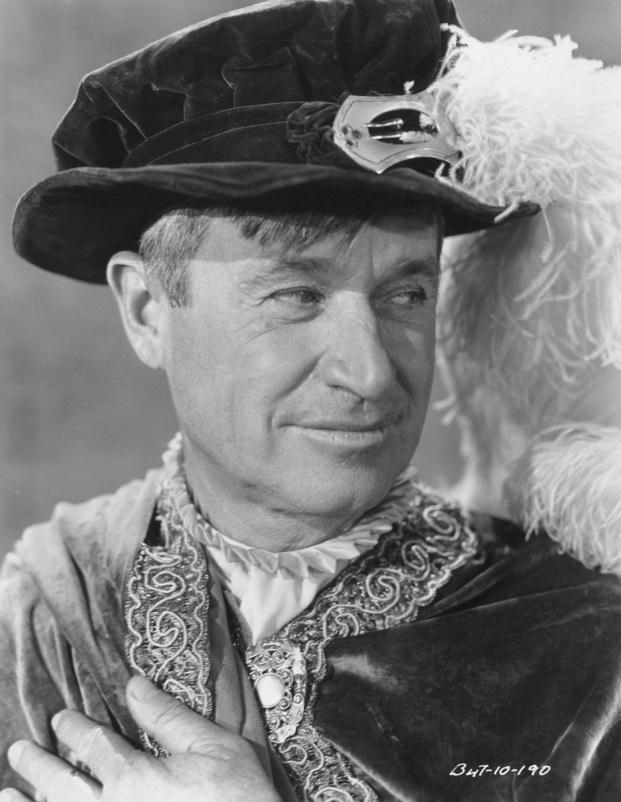
Will Rogers in costume for his role as a contemporary American who magically winds up in Camelot with King Arthur and his Knights of the Round Table. The movie is on VHS tape but not on DVD yet. I saw the VHS tape back in '92 and it was a lot of fun.
wikipedia
A Connecticut Yankee is a 1931 American Pre-Code film adaptation of Mark Twain's 1889 novel, A Connecticut Yankee in King Arthur's Court. It was directed by David Butler to a script by William M. Conselman, Owen Davis, and Jack Moffitt. It was produced by Fox Film Corporation (later 20th Century Fox), who had earlier produced the 1921 silent adaptation of the novel, A Connecticut Yankee in King Arthur's Court. A Connecticut Yankee is the first sound film adaptation of Twain's novel. As in The Wizard of Oz, many of the actors in the film play more than one role, a character in the real world and one in the dream world. The film stars Will Rogers as Hank Martin, an American accidental time traveler who finds himself in Camelot back in the days of King Arthur (William Farnum, a Fox star for many years). Myrna Loy and Brandon Hurst play the evil Morgan le Fay and Merlin, who must be overcome by Hank's modern technical knowledge, while Maureen O'Sullivan plays Alisande. Fox was likely inspired to produce A Connecticut Yankee based on the success of the 1921 silent film. The 1931 version was likewise successful, and was re-released in 1936. It is unrelated to the 1927 musical also titled A Connecticut Yankee. The hero's name was changed from Hank Morgan to Hank Martin, possibly because the original name sounded too similar to that of actor Frank Morgan.
Will Rogers ... Hank Martin
William Farnum ... King Arthur / Inventor
Frank Albertson ... Emile le Poulet / Clarence
Maureen O'Sullivan ... Alisande / Woman in Mansion
Brandon Hurst ... Merlin / Doctor in Mansion
Myrna Loy ... Queen Morgan le Fay / Evil Sister in Mansion
Mitchell Harris ... Sagramor / Butler in Mansion
tcm.com
A CONNECTICUT YANKEE (1931) William Penn Adair Rogers (1879-1935), born in Oklahoma when it was still Indian Territory, was part Cherokee. He also was America's most beloved humorist for years before he died in a plane crash in Alaska, a star of vaudeville, Broadway, radio, movies and, for good measure, a widely syndicated newspaper columnist. His Cherokee heritage may have contributed to the everyman outsider stance that gave underpinning to his gentle wisecracks, full of populist keenness. When he said things like, "My ancestors may not have come over on the Mayflower, but they met 'em at the boat," it was shorthand for the way he bonded with audiences by reminding them that he, like they, were on the outside of the power structure, but it didn't mean they couldn't poke fun at it. He could have been Mark Twain's gentler sibling.
He teamed up with Twain, sort of, in a 1931 film of Twain's 1889 time-travel fantasy, A Connecticut Yankee in King Arthur's Court, shortened to A Connecticut Yankee. Rogers, a real cowboy who grew up on his family's ranch, began his showbiz career in Wild West shows as a lariat virtuoso, worked jokes into his routines, much as W.C. Fields, who began as a juggler, did. By the time of A Connecticut Yankee, Rogers had dozens of films under his belt, some with such self-descriptive titles as Cupid the Cowpuncher (1920), The Ropin' Fool (1922) and The Cowboy Sheik (1924). People loved his barbed but never vitriolic one-liners delivered in an aw-shucks hayseed fashion that blinded nobody to their shrewd, bemused skepticism - a quality that never fails to win American audiences, especially when applied to so-called political life. He and his cowboy persona were relaxed and comfortable. They relocated easily from the bunkhouse of a ranch to a Main Street storefront in Connecticut, where his character, Hank Martin, runs a radio shop, houses the local radio station and fronts the programs in cracker-barrel fashion.
One stormy night, Hank gets a call to deliver a car-sized radio battery to a spooky stone mansion on a hill. There he meets a stone-faced butler, an imperious lady of the house, her daughter, whose engagement to a boy she considers plebian she opposes, and the dotty paterfamilias, an inventor who needs the big battery to test his belief that he can tune in on the past. No sooner do Hank and the old inventor hear voices from King Arthur's time than a French window blows open, knocking over a suit of armor, which lands on Hank, conking him out. The framing device then yields to the story within a story, which has fun with the idea of modern inventions transplanted to 528 A.D. "Canst tellest me where the hellest I am?" Hank drawls to the knight who drags him in chains to Camelot's round table. When he dazzles the court by producing instant fire from his cigar lighter, the jealous Merlin (Brandon Hurst), seeing the newcomer as a rival, sells Arthur on the idea of burning Hank at the stake.
A Connecticut Yankee takes a lot of liberties with the book, an approach that works disarmingly, reinforcing the idea that we're watching something freewheeling and zany. More important than not taking the book totally seriously, the film's eight writers convince us that we're watching a film that never takes itself too seriously, befitting a dream. Its structure, such as it is, fits Rogers's casual style comfortably as Hank's dozing mind recasts the mansion's denizens into Camelot's principals. Thus the inventor (William Farnum) is transformed into Arthur, the unreceptive butler (Mitchell Harris) becomes a hostile knight, the high-handed lady (Myrna Loy) is reincarnated into Arthur's evil sister, Morgan Le Fay, while the lovelorn ingénue from the mansion (Maureen O'Sullivan) becomes the high-born lady forbidden from marrying the commoner in both worlds (Frank Albertson). The latter figures in one of the asides: Hank gets the young man upgraded to royal rank, having him dubbed Sir Rogers de Claremore (a genuflection to Rogers's Oklahoma home town).
Hank's turnaround is launched by the book's juiciest scene. Just before Hank is about to be burned, he learns from the handy-dandy pocket almanac he carries that June 21, 528 A.D. - the date of his scheduled execution - was also the date of a solar eclipse. Surrounded by kindling, he proclaims his intention to blot out the sun. When it happens, Hank's fortunes soar as he pretends to make the sun reappear. Dubbed Sir Boss by the impressionable Arthur, he swings into 20th century action, including taking on the enemy knight in a joust, exchanging lance and armor for cowboy hat and chaps, then lassoing his adversary to the ground. After proclaiming himself a Democrat in favor of prosperity, farm relief, freedom for Ireland and beer for all, Hank sets about industrializing Camelot along modern lines. In no time, the screen is filled with switchboard operators in medieval garb, mass-produced miscellany and an assembly line of which Henry Ford would have been proud. Then, in a meeting of minds with Twain, Rogers announces that he's inventing advertising in order to make people want what they had been perfectly happy without.
Twain's vernacular is right in Rogers's wheelhouse, and he makes the delivering of it seem easy. His offhand manner encourages receptivity to the film's absurdities, not that the glut of 20th century stuff his Camelot factories turn out doesn't come in handy. When Hank and Arthur learn Morgan Le Fay has, with the help of a treacherous Merlin, kidnapped the princess, and they ride off to rescue her only to wind up on the gallows, about to be hanged, the Camelot cavalry comes to the rescue. In a scene of delightful excess, a fleet of flivvers bounces over the enemy turf, augmented by tanks, planes and a helicopter that bombs Morgan Le Fay's castle to rubble. It enables the film to end on a bang-up note of rising nonsense, with everybody, including the deadpan baddies, drawing us into the good time they convince us they're having.
While such veterans as Farnum and Hurst are the means of poking gentle fun at old styles steeped in the staginess that often spilled over into early talkies, Ireland's O'Sullivan brings youthful freshness to a stock ingénue role, and Loy is a delight. Cast in a string of troublemaker roles at that early stage of her career, she brings a playful sexiness to Morgan Le Fay, even in the improbable scenes in which she's supposed to have fallen for Hank and romances him in a good-humored vampish way. Neither she nor Rogers could have known that she'd also bring a dash of color to those scenes. Director David Butler had the idea to have Hank's face hand-tinted pink in every frame of every print of their love scene, and so it was. (Loy later wrote that Rogers was essentially a shy man in real life.) A Connecticut Yankee may look slapdash - at times its action, especially when played out against obviously painted flat backgrounds, is only a notch or two above Three Stooges production values. But its winning goofiness conceals a lot of professional savvy, not least of all from Rogers, whose homespun awkwardness and slightly nasal twang may have begun as the real thing, but by 1931 belonged to the realm of the art that concealed art.
Director: David Butler
Screenplay: William M. Conselman, Owen Davis, based on the novel A Connecticut Yankee in King Arthur's Court by Mark Twain
Cinematography: Ernest Plamer
Art Direction: William S. Darling
Music: Arthur Kay
Film Editing: Irene Morra
Cast: Will Rogers (Hank Martin aka Sir Boss), William Farnum (King Arthur/Inventor), Frank Albertson (Emile le Poulet/Clarence), Maureen O'Sullivan (Alisande/Clarence's Sweetheart), Brandon Hurst (Merlin/Doctor in Mansion), Myrna Loy (Queen Morgan le Fay/Evil Sister in Mansion), Mitchell Harris (Sagramor/Butler in Mansion). BW-95m.
by Jay Carr
Sources: IMDb AFI Catalogue of Feature Films
Will Rogers: A Biography, by Donald Day, David McKay, 1962
Will Rogers, Performer, by Richard J. Maturi and Mary Buckingham Maturi, McFarland, 1999
Will Rogers in Hollywood, by Bryan B. Sterling and Frances N, Sterling, Crown, 1984
Will Rogers Biography, by Joseph H. Carter, willrogers.com
Myrna Loy: Being and Becoming, by James Kotsilibas-Davis Myrna Loy, Knopf, 1987
The Films of Myrna Loy, by Lawrence J. Quirk, Citadel Press, 1980
Maureen O'Sullivan: "No Average Jane," by David Fury, Artist's Press, 2007
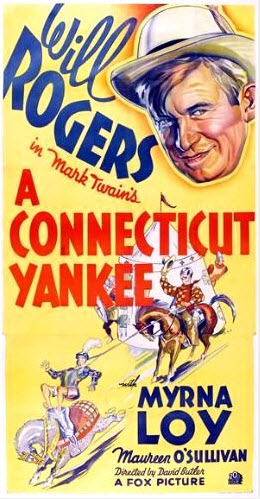
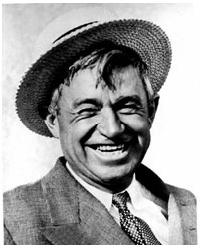
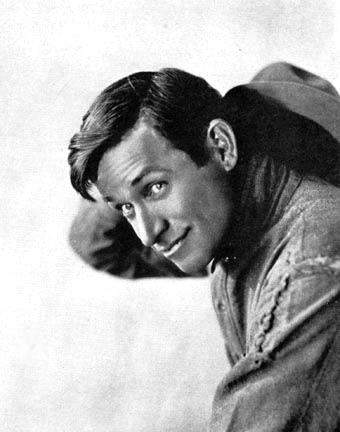
This is a tiny photo but is a good one of Will smiling broadly. Those flat topped straw hats were very fashionable during the "turn of the century" they were nicknamed "skimmers" . . . could probably be thrown like a Frisbee to great distances. The second photo is of Will when he was in the Ziegfeld follies, telling stories and commenting on American life while he twirled his lariat. Being an Oklahoma cowboy he was an expert at rope tricks while chewing gum.
Will Rogers Doing Rope Tricks youtube
Will Rogers - The Ropin' Fool 1922 youtube narrated by his son Will Rogers Jr.
Will Rogers - Bacon, Beans, and Limousines youtube

Return to Steamboat Round the Bend Program
All captions provided by Dave Thomson, Steamboats.com primary contributor and historian.
